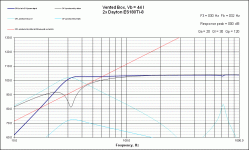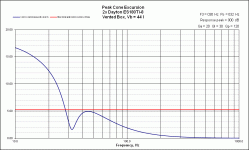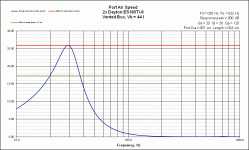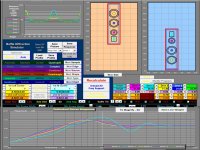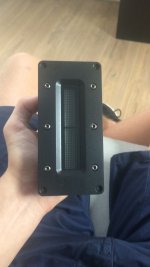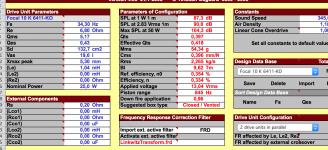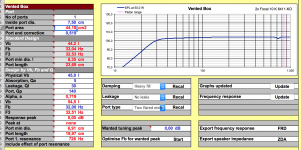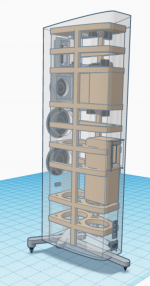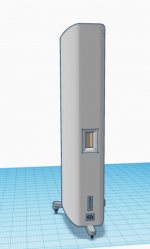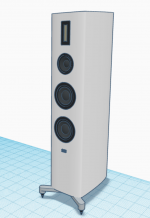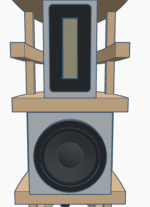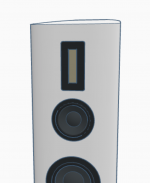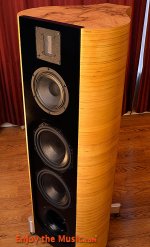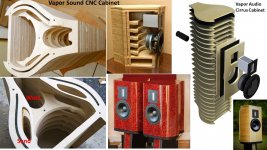Hmm, I'm not saying you're wrong but an F3 of 33 Hz out of these towers I find way too high. I was already sad not being able to go subsonic when I had to throw my sub out of the window but these towers not even going below 30 Hz just doesn't meet my needs.
Maybe then I should go transmission line, a good transmission line is supposed to go lower than bass reflex right?
Maybe then I should go transmission line, a good transmission line is supposed to go lower than bass reflex right?
Hmm, I'm not saying you're wrong but an F3 of 33 Hz out of these towers I find way too high. I was already sad not being able to go subsonic when I had to throw my sub out of the window but these towers not even going below 30 Hz just doesn't meet my needs.
Maybe then I should go transmission line, a good transmission line is supposed to go lower than bass reflex right?
I think you may be over estimating the capabilities of 2- 7" woofers. An f3 of 33hz at over 100db is respectable.
Vb = 44L
Fb = 32Hz
F3 = 29.9Hz
Port D = 7cm
Port L = 24cm
Never been that interested in TL's, so I can't help you there.
I do suggest that you read up a little on room gain though. It makes the in-room F3 a little bit more important than the F3 modeled in a box program.
Fb = 32Hz
F3 = 29.9Hz
Port D = 7cm
Port L = 24cm
Never been that interested in TL's, so I can't help you there.
I do suggest that you read up a little on room gain though. It makes the in-room F3 a little bit more important than the F3 modeled in a box program.
Attachments
Yeah, I'm already looking at making something with a Dayton 8" Ultimax built-in subwoofer. In this enclosure it would go down to 22 Hz. But I doubt if it would sound as good in the real world as it seems in a model. And then there's the aesthetics...
Attached... Simple baffle diffraction simulation of a TM-WW topology with ribbon + 5" mid + two 8" woofs on 1" radius baffle to help visualize how edge diffraction, baffle step, and driver-baffle position affect SPL. This information can help optimize a design. Does not include room shape, speaker placement, listener position, etc...
The simulator generates FRD equalization files for each driver as shown in the graph which the designer can use for early crossover development -before measurements.
The simulator generates FRD equalization files for each driver as shown in the graph which the designer can use for early crossover development -before measurements.
Attachments
Thanks, really helps. I won't need the equalization files though. With the MiniDSP you simply set the crossover frequencies, measure the entire thing at once and in does all of the equalization and room correction as perfect as it can possibly get for you with a mouse click.
By the way. The idea with the 8" subwoofer is already dead before it has been born. It's way to expensive and I personally don't really like tower speakers with a single (visible) tiny woofer so especially with with a cabinet this big, I find it ugly AF.
I think I've got the golden ratio here. It has a F3 of over 32 Hz but now I can squeeze 25 watts and understanding I was overestimating these woofers at first I'm totally happy with that performance, I mean, as if 32 Hz isn't already pretty deed. And if I'm still not satisfied with the bass performance in real life (which is seriously doubt) I can add a subwoofer that does go to around 20 Hz for really pretty cheap actually. I've been looking around and the Dayton Audio Classic Series subwoofer drivers for their size and price go surprisingly low with ease.
Attachments
Go for it, I don't feel you'll be wanting for bass with these woofers. I'm going for a slightly lower tuning to have a more gradual roll off. On paper this actually raises the f3 but gains a little more deep bass. With room gain it shd be a nice balance.
I've integrated the port in my design. Because of the 25 mm thick MDF I'll be using to build the cabinet the port actually takes in exactly enough space to get the net Vb from 50 to 45 L. The port entrance will be at 50 cm high from the bottom of the cabinet to minimize reflections with the ground.
And well I think I'm clear to say this design will be complete then. Feels weird to say that after almost two years of continuous grinding for this single project.
Thanks for all great your great advice, this has been my best and most useful thread on this forum ever! I also really like how this thread went from which mid woofer I should use to the bass enclosure in the entire design.
🙂
And well I think I'm clear to say this design will be complete then. Feels weird to say that after almost two years of continuous grinding for this single project.
Thanks for all great your great advice, this has been my best and most useful thread on this forum ever! I also really like how this thread went from which mid woofer I should use to the bass enclosure in the entire design.
🙂
Attachments
Last edited:
looks great! I wd push the mid closer to the ribbon.
like the 3 leg stand, doing something similar.
your cab design is really good actually
like the 3 leg stand, doing something similar.
your cab design is really good actually
this is what the project has finally evolved to: Active sealed tower speakers using SB-Acoustics Satori drivers : diysound
I still have those Dayton mid woofers laying around though. Might be useful one day now I know how to properly design a speaker.
f##k me, you used the woofers I want to use next!
Great application etc, clever stuff! Ie Sealed with dsp
My idea was to go isobaric with these(passive x/o)
25hz f3, 35 litres box minus port, 88db ..not bad.
Great application etc, clever stuff! Ie Sealed with dsp
My idea was to go isobaric with these(passive x/o)
25hz f3, 35 litres box minus port, 88db ..not bad.
Did you get a CNC for Christmas?
ONLY... 84 translam layers needed for the Vapor Derecho cabinet!
Vapor audio uses advanced translam profile layers which reduce edge diffraction; support 3D cross-bracing; create volumes for wool for rear wave absorption, and sand for vibration reduction.
Thought you would enjoy this comparison build method.
ONLY... 84 translam layers needed for the Vapor Derecho cabinet!
Vapor audio uses advanced translam profile layers which reduce edge diffraction; support 3D cross-bracing; create volumes for wool for rear wave absorption, and sand for vibration reduction.
Thought you would enjoy this comparison build method.
Attachments
Last edited:
- Status
- Not open for further replies.
- Home
- Loudspeakers
- Multi-Way
- which mid-woofer is better?
